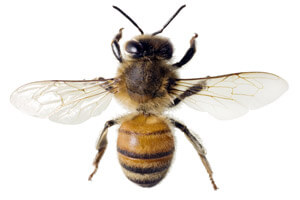
Introduction
The agricultural environment is a source of chemical exposure for bees, with pesticides, their degradation products, and other ingredients in pesticide products (adjuvants, solvents, and other chemicals added to formulated products) dominating the scene. Because multiple pesticide products are applied to a crop, honey bees foraging on or near the crop will typically bring multiple chemicals back to the hive in pollen, nectar and/or water. In-hive miticides are also part of the picture. Indeed, most analyses of hive materials (pollen, wax, bees, honey) taken from beehives in agricultural areas show that multiple agricultural and miticidal chemicals are present.1, 2, 3
As we think about the potential effects of these chemicals on bee health, it becomes clear that we need to know not only how the individual chemicals affect bees, but also whether the mixture alters the toxicity of individual components. There are three possibilities:
- Additive: Toxicity is simply the sum of the toxicity across the individual components;
- Antagonistic: The mixture is less toxic than the sum of its components would suggest; and
- Synergistic: The mixture is more toxic than the sum of its components would indicate.
In this Curious Beekeeper article, we’ll explore the occurrence of synergistic effects, where 1 + 1 is greater than 2.
The Bouncer
It might sound impossible, but there is a firm basis in science for the synergistic effects observed for mixtures of chemicals. It all has to do with how insects (and humans) detoxify chemicals. An analogy is illustrative here.
You’ve seen the cartoon–a bad guy walks into the room and starts to make trouble. But not to fear! The big bouncer guy by the door walks over and picks him up by the scruff of the neck and tosses him bodily out the door. The bad guy gets a black eye and bruises in the process and heads off into the distance. But if the bouncer is on vacation, the bad guy can do whatever he pleases without consequences.
This scenario has much in common with the system used by both humans and insects to detoxify chemicals. In this case, the bad guy is a toxic chemical and the bouncer is a group of enzymes that react with the toxic substances. The chemicals are transformed in the process of interaction with the enzymes, which reduces chemical toxicity and facilitates excretion of the toxic substance. But if the enzyme system is disabled by a synergist, it’s as if the bouncer is on vacation. The toxic chemical is not degraded or excreted, and toxic effects are observed at a much lower dose than without the synergizing chemical.
How Detoxification Works
The most common family of enzymes responsible for detoxifying foreign chemicals in biological systems is the cytochrome P450 group (CYP).4 There are other enzymes involved, but because the CYP group is the primary system for detoxification in insects, we’ll focus on it here.
A set of genes codes for the CYP proteins, and different species and even different individuals have a different mix of CYP variants, with marked variability in the ability to detoxify chemicals. This genetic basis of detoxification accounts for much of the variability in the sensitivity of both humans and insects to chemical substances. It also explains why some people can drink a cup of coffee at midnight and go right to sleep while others have to cut caffeine intake early in the day if they hope to get a wink of sleep.
In insects, CYP enzymes have been studied extensively for their role in the development of resistance to insecticides.5, 6 Insects with CYP enzymes that rapidly degrade an insecticide are resistant to its effects, survive the insecticide treatment, and live to reproduce and pass these resistant genes on to their offspring. In the context of beekeeping, fluvalinate-resistant Varroa mites have genes that produce CYP that is very efficient at detoxifying fluvalinate, so it has little effect on the mites.
Exposure to a chemical may have one of several possible effects on the CYP system. The primary ones are:
- Induction and activation: CYP enzyme activity is enhanced in the presence of the chemical, and the result is a substance that is more toxic than the starting chemical. An example here is the transformation of an organophosphorus insecticide like chlorpyrifos (Dursban®) to its much more toxic oxon form that is then further metabolized and excreted.
- Induction and deactivation: CYP enzyme activity is enhanced in the presence of the chemical and the result is a species that is less toxic than the starting chemical. The adaptation of insects to eating toxic plants is based in their ability to degrade toxic substances in the plant to benign ones.
- Inhibition: CYP enzyme activity is suppressed, allowing toxic chemicals to persist in the …


